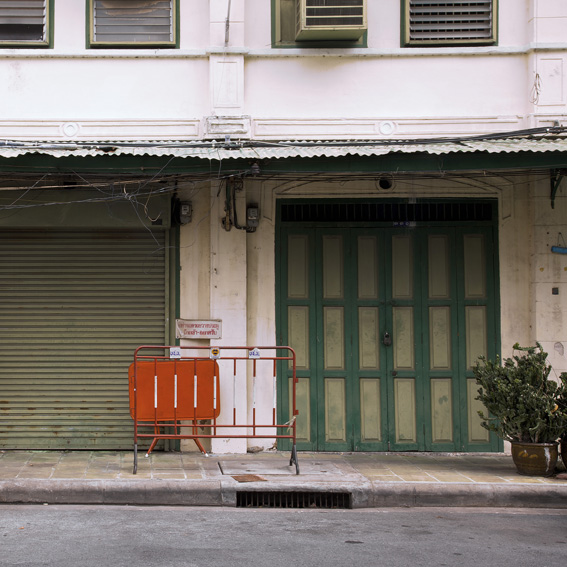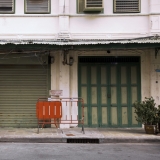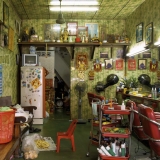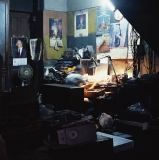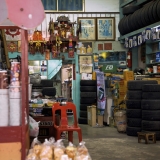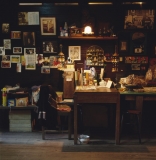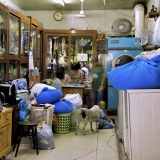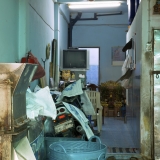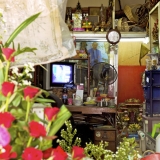4 x 8
A photo exhibition by
Peter Nitsch
7 August – 26 September 2010
4 x 8 metres — the cramped dimensions of your average Bangkok shophouse, which is used exactly as described: both as a shop and as a house, “condensing entire lifestyles…crammed full to the last centimetre.” As lovingly photographed still-lifes by German Peter Nitsch, shophouses are family homes that open to the world, private and public, at once a market and a sanctuary of peace.
Artist’s statement
The city as a living space, and that with its related concept of urbanism as a social phenomenon that according to Louis Wirth describes the rationalised lifestyle of urban people in comparison to the provinciality of rural inhabitants, is among the great themes of contemporary photography. Barely uttered, the “magic word” creates in our minds large pictures in which develop the technological aesthetic of urban-building excesses in globalised mega-cities. What we often forget in this respect is a second dimension of urbanism, which embraces the coexistence of various types of people, each with their own identity, in a limited living space. With his 4 x 8 m Bangkok/Shophouses series of works, Nitsch focuses precisely on this dimension.
Beyond the skyscrapers and neon signs, which also increasingly oust the traditional cityscape of Bangkok, the photographer-artist, who was born in Munich in 1973, grants us an intimate view of the retail businesses that are typical of Southeast Asia and the lives of their owners. For many of them the mostly two-storey shop, that on the lower level is open to the street, is workplace and living space in one. Thus Nitsch’s photographs condense entire lifestyles in cramped surrounding that are often crammed full to the last centimetre and nevertheless radiate an almost meditative peace.
This peace is surprising because, as noted by Roman Rahmacher, himself an authority on Asia and picture editor with Gruner + Jahr, it is “diametrically opposed to the Bangkok that I have previously been aware of.” And it is a fact that for European eyes it is only a bewildering confusion at first glance. But if one allows the pictures to make an impression, a fractal pattern with a high degree of similarity is to be gradually recognised in the overfilled rooms, which from the sheer number of objects suddenly makes a structured Mandelbrot set. The chaos becomes a cosmos and thus transforms into its opposite: an orderliness, to which the photographs additionally lend their characteristic power of peace.
With 4 x 8 m Bangkok/Shophouses, Nitsch has managed to capture with a very precise view an unusual subject that is slowly being forgotten and which above all reminds us Europeans how one can live and photograph urbanity. It is exactly that which makes these pictures so worth seeing.
Bio
Peter Nitsch is among the advanced representatives of documentary photographic art in Germany. His works have been multiply distinguished, among others with the bronze medal of the renowned Los Angeles International Photography Award and as a Hasselblad Masters semifinalist. Nitsch lives and works in Munich and Bangkok. The cultural process of upheaval in Southeast Asia and especially the conflict between Thai identity and the globalised living conditions in the region are focuses of his photographic work.
4 x 8
นิทรรศการภาพถ่ายโดย
พีเตอร์ นิท์ช
7 สิงหาคม – 26 กันยายน 2553
4 x 8 เมตร – ความคับแคบของห้องแถวขนาดมาตรฐาน ซึ่งใช้เป็นร้านค้าและบ้านอยู่อาศัย ภายในขอบเขตนี้การใช้สอยชีวิตหลากแบบอัดแน่นเต็มพื้นที่ทุกตารางนิ้ว ในผลงานภาพถ่ายของ พีเตอร์ นิท์ช ช่างภาพเยอรมัน ห้องแถวที่เราเห็นจนคุ้นตากลับกลายเป็นภาพหุ่นนิ่งอันสวยงามละเมียดละไม บอกเล่าถึงบ้านและครอบครัวที่เปิดอ้าสู่โลกภายนอก มีทั้งความเป็นส่วนตัวและความเป็นพื้นที่สาธารณะในขณะเดียวกัน เป็นทั้งตลาดและที่พักพิงทางกายและจิตใจ
พีเตอร์ นิท์ช ถูกจัดเป็นช่างภาพศิลปะเชิงสารคดีแนวหน้าของเยอรมัน เขาได้รับรางวัลสำคัญมาแล้ว อาทิจาก ลอส แองเจลิส อินเตอร์เนชั่นแนล โฟโต้กราฟี อวอร์ด ปัจจุบันอาศัยและทำงานอยู่ที่มิวนิคและกรุงเทพ ภาพถ่ายของเขามุ่งสะท้อนเรื่องความขัดแย้งระหว่างอัตลักษณ์ไทยกับกระแสโลกาภิวัตน์
…………………………………………


